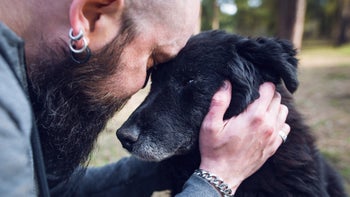
How to Recognize and Prevent Heatstroke in Dogs
Key takeaways:
Heatstroke in dogs is life-threatening, so it’s important to recognize the symptoms early.
If heatstroke occurs, you need to start cooling your dog and seek immediate veterinary help.
You can prevent heatstroke by limiting your dog’s activity when it’s hot outside, and never leave your dog alone in an enclosed car.
Your dog may love playing outside on warm days. But hot temperatures and overheating can be life-threatening. Knowing the symptoms of heatstroke in dogs will help you recognize this condition and take action. If you quickly start to cool your dog and get them to the vet, you can improve their chances of survival and recovery.
In this article, we’ll look at what heatstroke is, how to recognize it in dogs, and what you should do if you suspect heatstroke.
What is heatstroke in dogs?
Heatstroke is a serious medical condition that happens if your dog’s body temperature reaches 105 degrees Fahrenheit or higher.
Search and compare options
According to Danel Grimmett, a licensed veterinarian at Sunset Veterinary Clinic in Edmond, Oklahoma, heatstroke occurs when your dog loses the ability to cool themselves.
Dogs typically cool themselves by panting since they don’t sweat. If a hot environment prevents that cooling ability, your dog can’t maintain a safe and normal body temperature.
If your dog’s body temperature gets too high, they can experience heatstroke. This dangerous overheating can be life-threatening, so it’s important to quickly get your dog help.
A word about heatstroke vs. heat exhaustion in dogs
Heatstroke and heat exhaustion are two terms that are used interchangeably, explains Dr. Grimmett. Both refer to hyperthermia, where your dog’s body temperature is way too high.
What are the causes of heatstroke in dogs?
Many situations can lead to heatstroke in dogs. According to Iowa Veterinary Specialties, leaving your dog in a car on a warm day is one example that can rapidly lead to heatstroke.
Temperatures inside a car in the sun can climb to 120 degrees Fahrenheit in 20 minutes. This can occur even when the temperature outdoors is just 75 degrees. In such a warm environment, some dogs can develop heatstroke in only 30 minutes. Death can occur within an hour.
Read more like this
Explore these related articles, suggested for readers like you.
Dogs don’t have to be left in a hot car to get heatstroke. Intense exercise in a hot, humid environment can make it difficult for a dog to cool themselves down. Playing on a hot day can also be dangerous for your dog, especially without access to shade and water.
Other factors can contribute to heatstroke. Large breed dogs and dogs with thick fur can be at a higher risk for this condition. Dogs who are obese or older can also be at increased risk.
It’s particularly easy for brachycephalic dogs — like pugs, bulldogs, and Boston terriers — to get heatstroke. These breeds have short noses, which makes it harder for them to breathe. Any breathing issues limit your dog’s ability to efficiently cool themselves by panting. As a result, they’re prone to overheating.
What are the signs of heatstroke in dogs?
If your dog experiences heatstroke, you might notice some or many of these symptoms:
Excessive panting and drooling
Red gums or tongue
Increased heart rate
Dry nose
Being unusually quiet
Not wanting to or not being able to get up
Vomiting
If heatstroke progresses and your dog’s body temperature continues to rise, they might experience the following symptoms:
Blood in their mouth or in their poop
Muscle tremors
Seizures
Incoordination or a staggering gait
Weakness
Collapse
Coma
Death
Dr. Grimmett warns that at the point of collapse, your dog’s situation may be fatal. It’s essential to quickly recognize the early symptoms of heatstroke and treat your dog right away.
What you can do to help an overheated dog
Heatstroke is a veterinary emergency. If you notice symptoms of heatstroke, your first priority needs to be cooling your dog. Move them to a shaded, ventilated area right away. An air conditioned space is ideal. Offer your dog cool water to drink and carefully monitor them.
As you do this, call your vet for help, and get ready to transport your dog. If your regular vet isn’t able to see your dog, call the nearest emergency clinic. If you notice your dog’s symptoms worsening, it’s essential to continue cooling them as you get veterinary help.
You can also cool your dog by running water over their body with a hose and by putting them in front of a fan. If you don’t have access to a hose, you can use wet towels or sponges. Use room temperature water as opposed to ice cold water to avoid shocking your dog. You can also wipe the bottoms of their paws with rubbing alcohol to help draw out heat.
If you have a rectal thermometer, take your dog’s temperature throughout the process. This can help you to monitor the severity of their condition.
When to take your overheated dog to the vet
Even if you’ve managed to lower your dog’s temperature, it’s still important to seek veterinary help for heatstroke. Serious issues like kidney failure, bleeding, and seizures can occur. A vet can help to minimize the chances of these complications or treat them if they happen.
Your vet will also monitor for dehydration and provide other supportive treatment for your dog’s symptoms.
What are the long-term effects of heatstroke on my dog?
Dogs experiencing heatstroke usually have a guarded to poor prognosis. In many cases, dogs die within 24 hours of experiencing heatstroke.
Dr. Grimmett notes that many dogs who survive heatstroke don’t have any long-term effects. However, if your dog’s body temperature was too high for a long period of time, they may live with permanent brain, kidney, or other organ damage.
What can I do to prevent heatstroke in the future?
You can prevent heatstroke by carefully monitoring your dog in warm weather. Dr. Grimmett recommends that you avoid excessive exercise, particularly on hot days.
Take your dog for a walk in the early morning or evening when the temperatures are cooler. Make sure your dog has access to shade and cool drinking water.
It’s also important to never leave your dog in a car or warm enclosed indoor area. “If it’s too hot and stuffy for you, it’s the same for them,” says Dr. Grimmett. And never assume your dog will be fine for just a few minutes.
In addition, consider your dog’s other risk factors for heatstroke. If your dog is at risk due to their breed, age, weight, or other health issues, talk with your vet. They can give you guidance on appropriate summertime exercise for your dog. Your vet may also have other heatstroke prevention tips based on your dog’s risk factors.
The bottom line
Heatstroke in dogs is life-threatening and can be fatal, especially without swift intervention. You can prevent heatstroke by carefully managing your dog’s activity during hotter weather. It’s also important to recognize heatstroke symptoms early on, like excessive panting or not having much energy. Acting quickly to cool your dog and getting immediate veterinary care can help to increase their chances of survival.
Why trust our experts?



References
Bruchim, Y., et al. (2017). Pathophysiology of heatstroke in dogs – revisited. Temperature (Austin).
Driscoll, J. (n.d.). Hot weather and your dog: Do you know the signs of heat stroke? Pet Poison Helpline.
Hamil, J. A. (2016). Heat stroke and heat exhaustion in dogs. American Kennel Club Canine Health Foundation.
Iowa Veterinary Specialties. (n.d.). Canine heat stroke.
Lengyel, K. (2018). The 3-tiered approach of treating heatstroke in dogs. DVM360.
Mazzaferro, E. (2015). Treatment of hyperthermia and heat-induced illness. World Small Animal Veterinary Association World Congress Proceedings.
Sunset Veterinary Clinic. (n.d.). Danel Grimmett, DVM.
Valas, C. (n.d.). Heat stroke in brachycephalic dogs. The Family Pet Hospital.




























